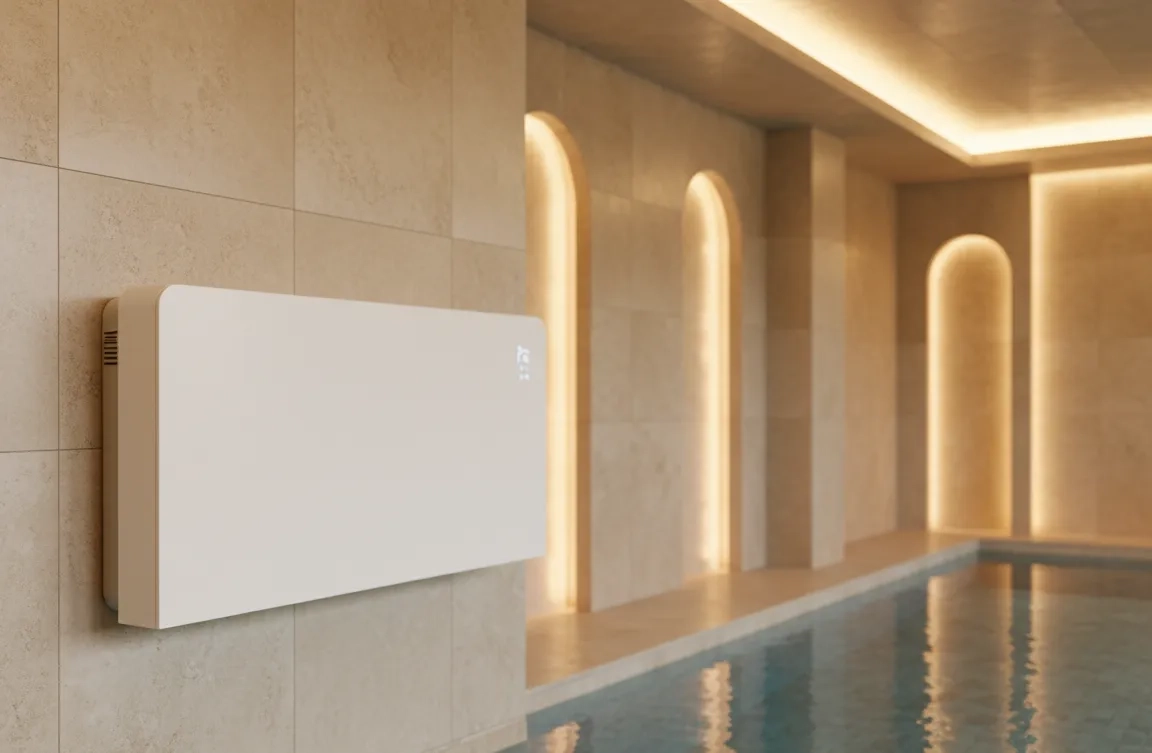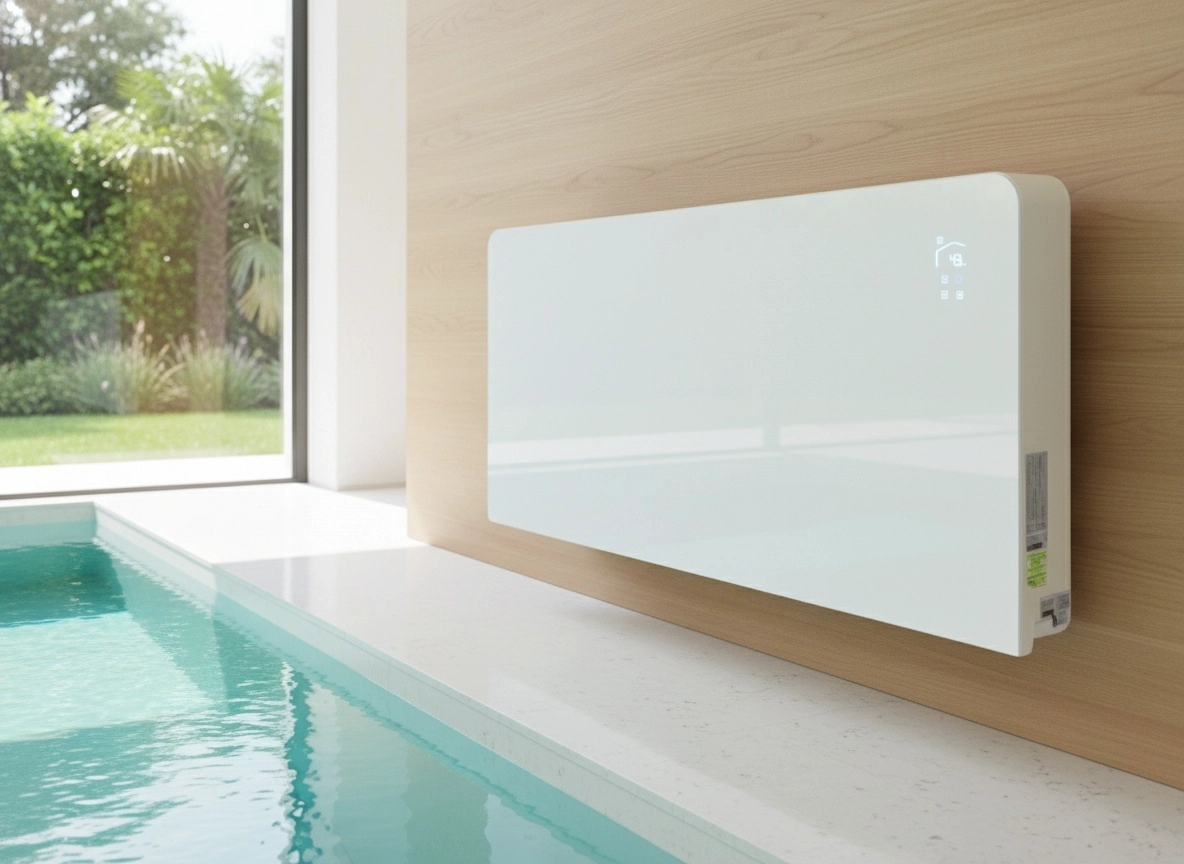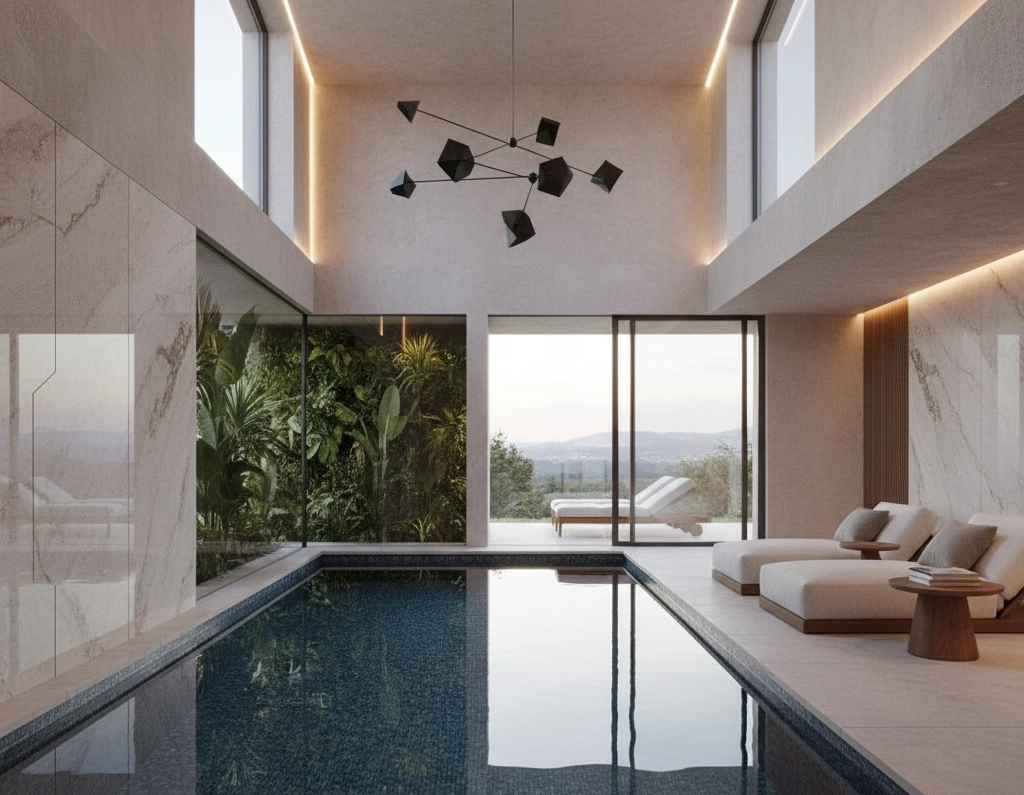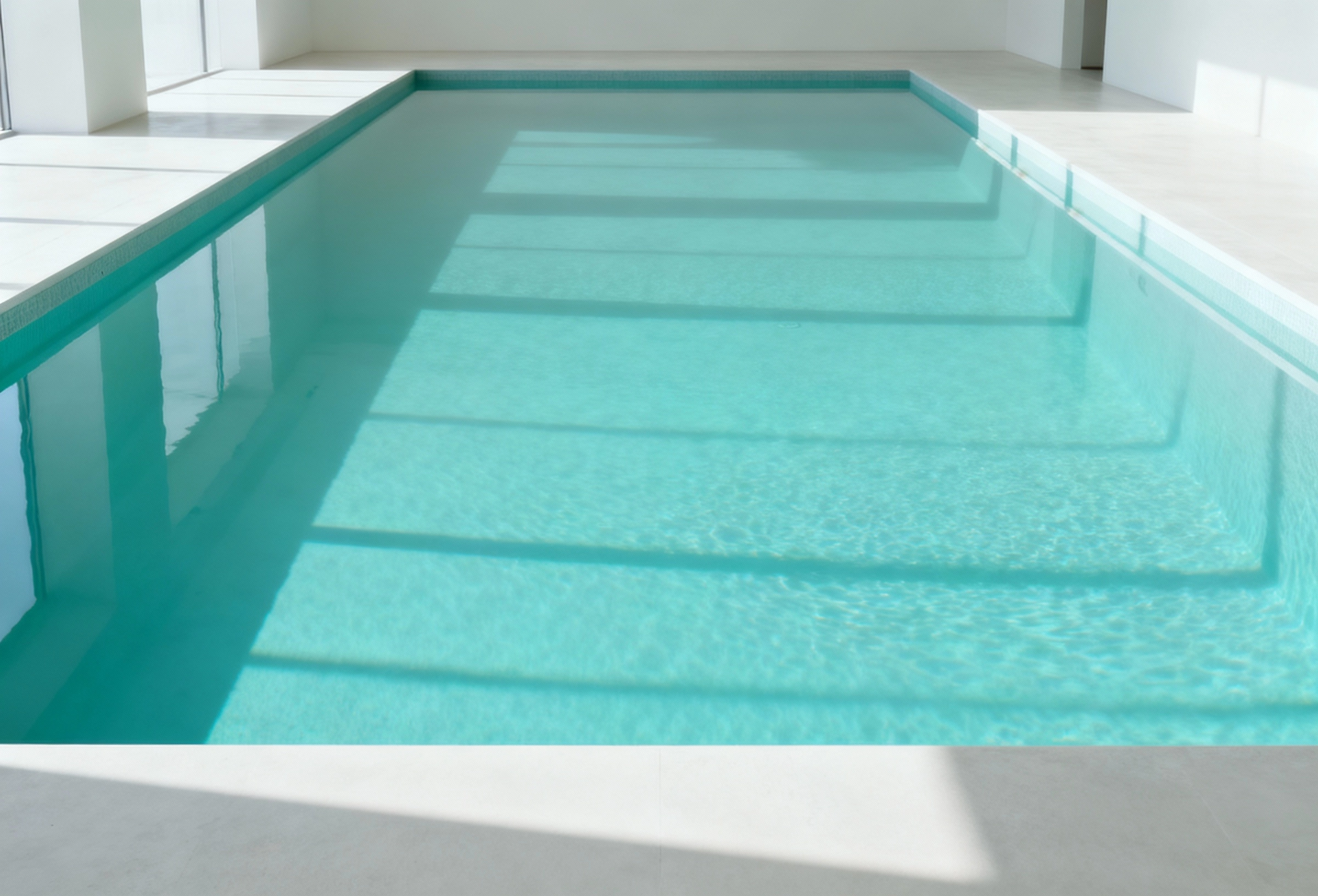
Owners of private pools often worry that installing a dehumidifier will lead to “astronomical” electricity bills. Many believe that if the unit runs around the clock, its consumption will be similar to heating the entire house. This myth stems from confusion with electric heaters, which really do draw 2–3 kW continuously when running nonstop.
The reality is different: a dehumidifier runs in cycles — the compressor automatically turns on and off depending on the air humidity. It does not run 24/7 at maximum draw, as many mistakenly assume. That’s why the actual electricity costs for a pool dehumidifier can be much lower than you expect.
In this article we provide specific figures and formulas to calculate the actual electricity consumption of MBA-G dehumidifiers. You will learn how to calculate costs for your pool and which factors influence energy consumption.

How a dehumidifier works
Rated vs. real power
First of all, it’s important to understand the difference between rated and real power. Rated power is the value specified in the device datasheet for active dehumidification mode. Maximum power is the peak load at compressor startup. Real average power accounts for duty cycles and is always lower than the rated value.
Here are specific figures from the official MBA-G specifications:
- MBA05G: nominal power 0.89 kW, maximum 1.89 kW
- MBA07G: nominal power 1.09 kW, maximum 2.09 kW
- MBA10G: nominal power 1.95 kW, maximum 2.7 kW
Cyclic operation with automation
The key to understanding a dehumidifier’s energy use is that it does not run at full power 24 hours a day. It works in cycles: once the target humidity is reached (e.g., 55%), the compressor turns off, and when humidity rises to the upper limit (e.g., 60%) — it turns on again.
A typical duty cycle looks like this: 30–40 minutes of active operation, then a 15–25 minute pause. Thus, the compressor’s actual runtime is approximately 14–16 hours out of 24. The rest of the time only the fan runs at minimal power (20–50 W) in monitoring mode.
Factors that affect consumption
Many factors influence the real energy consumption of a dehumidifier:
- Pool size and water temperature — larger surface area and higher temperature increase evaporation
- Frequency of pool use by people — active use increases evaporation
- Presence of a pool cover — significantly reduces evaporation
- Quality of room ventilation
- Outdoor air temperature — higher in winter, lower in summer
- Room insulation — better insulation reduces condensation and dehumidifier runtime
Formula for calculating electricity consumption
To accurately calculate the electricity consumption of a pool dehumidifier, use the following step-by-step formula:
Step 1: Determine the active runtime
Active time = 24 hours × Load factor
The load factor depends on the intensity of pool usage:
- Active daily use: 0.60–0.70 (14–17 hours of operation)
- Use 3–4 times a week: 0.45–0.55 (11–13 hours)
- Occasional use (1–2 times a week): 0.30–0.40 (7–10 hours)
Step 2: Calculate daily consumption
Daily consumption (kWh) = Rated power (kW) × Active time (h)
Step 3: Calculate monthly and annual consumption
Monthly consumption (kWh) = Daily consumption × 30
Annual consumption (kWh) = Daily consumption × 365
Example calculation for MBA07G
Take the MBA07G dehumidifier with a rated power of 1.09 kW for a pool used daily:
- Load factor: 0.65
- Active time: 24 × 0.65 = 15.6 hours
- Daily consumption: 1.09 kW × 15.6 h = 17 kWh
- Monthly consumption: 17 kWh × 30 = 510 kWh
- Annual consumption: 17 kWh × 365 = 6205 kWh
It’s important to note that these are average values. Actual consumption may vary by ±15–20% depending on operating conditions.

MBA-G real-world consumption table
The table below shows the energy consumption of different MBA-G dehumidifier models for three typical usage modes:
| Model | Rated power | Active use (daily) | Moderate use (3–4 times/week) | Infrequent use (1–2 times/week) | ||||||
|---|---|---|---|---|---|---|---|---|---|---|
| kWh/day | kWh/month | kWh/year | kWh/day | kWh/month | kWh/year | kWh/day | kWh/month | kWh/year | ||
| MBA05G | 0.89 kW | 13–15 | 390–450 | 4745–5475 | 10–12 | 300–360 | 3650–4380 | 6–8 | 180–240 | 2190–2920 |
| MBA07G | 1.09 kW | 16–19 | 480–570 | 5840–6935 | 12–15 | 360–450 | 4380–5475 | 7–10 | 210–300 | 2555–3650 |
| MBA10G | 1.95 kW | 28–33 | 840–990 | 10220–12045 | 21–26 | 630–780 | 7665–9490 | 13–18 | 390–540 | 4745–6570 |
The ranges in the table account for different evaporation intensity depending on the season and operating conditions. In winter, electricity consumption can be 10–15% higher because cold air condenses moisture more intensively. In summer, on the contrary, consumption can be 10–15% lower because warm air is less prone to condensation.
Comparison with other appliances
Compared to household appliances
To better understand the dehumidifier’s consumption scale, let’s compare it with other household appliances:
- Electric heater (1.5–2 kW × 8 hours) = 12–16 kWh per day
- Air conditioner in cooling (1–2 kW × 10 hours) = 10–20 kWh per day
- Electric kettle (2 kW × 0.5 hours) = 1 kWh per day (peak load)
- Modern A++ refrigerator = 0.3–0.5 kWh per day
- Washing machine = 1–2 kWh per cycle
- MBA07G dehumidifier ≈ 17 kWh per day
As we can see, an MBA-G dehumidifier consumes roughly as much electricity as 1–2 air conditioners in active mode, but it runs with automatic pauses thanks to its cyclic operation.
Annual consumption in the context of total home usage
To assess the overall impact of a dehumidifier on your budget, consider annual consumption:
- An average apartment (100 m²) consumes 3000–5000 kWh per year
- A detached house (150 m²) with electric heating — 15,000–25,000 kWh per year
- A house with a pool and an MBA-G dehumidifier — an additional 4000–7000 kWh per year, which is roughly a 20–30% extra load for an average home
It’s important to understand that a pool inherently involves additional costs (water, chemicals, heating, filtration), and a dehumidifier is a necessary part of this system to protect the room from damage, not a luxury item.
How to reduce electricity consumption
1. Pool cover (effect up to −30%)
Evaporation occurs directly from the water surface. A closed cover reduces evaporation by 60–70%, so the dehumidifier runs much less, yielding 25–30% electricity savings. It’s important to note that a cover pays for itself in 1–2 years just from dehumidifier electricity savings.
2. Proper target humidity
Don’t set humidity too low unless necessary. Every 5% below the optimal level increases consumption by 10–15%. The optimal pool humidity is 55% within the 50–60% range. At 40% you’ll get not only discomfort but also overconsumption of electricity.
3. Regular filter cleaning
Dirty filters create additional resistance to airflow, forcing the compressor to work harder, which increases consumption by 15–20%. Cleaning every 2–4 weeks is essential, as is timely replacement of worn filters.
4. Room insulation
Cold walls lead to more condensation and, accordingly, more dehumidifier runtime. Insulating walls and ceiling reduces consumption by 10–15%. It’s also important to install energy-efficient double-glazed windows.
5. Proper ventilation
A dehumidifier combined with proper ventilation works more efficiently than a dehumidifier alone at maximum power. Supply and exhaust ventilation removes part of the moist air, reducing the load on the dehumidifier.
6. Temperature settings
Don’t overheat water and air unnecessarily. Every additional degree of water temperature increases evaporation by 5–7%. Keeping water at 26°C instead of 28°C reduces evaporation by ~10%, which lowers the dehumidifier load.
7. Inverter technology for future purchases
A conventional compressor works on an on/off principle (100% or 0%). An inverter compressor can smoothly modulate power from 30% to 100%, saving up to 30% electricity. Currently, this technology isn’t available in all MBA-G models.
With a comprehensive approach, real savings can reach up to 50% of initial consumption: cover (−30%), correct humidity setting (−10%), clean filters (−15%), room insulation (−10%).

Expensive or acceptable
How to calculate your costs
To calculate your actual electricity costs for your dehumidifier, use a simple formula:
Your cost = Consumption (kWh) × Your rate
How to find your rate? Check your electricity bill — it shows the tariff in your currency per kilowatt-hour. Also consider time-of-use pricing (day/night) if it’s available in your region.
Example calculation with a notional rate: the MBA07G consumes about 510 kWh per month. If your rate is X currency per kWh, then the monthly cost will be 510 × X.
Assessment: expensive or not
To understand whether dehumidifier costs are high, compare them with other pool maintenance expenses:
- Water heating (if present) usually costs several times more than dehumidification
- Pool chemicals and water treatment also represent significant expense items
A dehumidifier is not a luxury but a necessity, like a water filter. It protects the room from deterioration and maintains a healthy indoor environment.
The cost of inaction
If you forgo a dehumidifier, the consequences may cost more than the electricity for running one:
- Condensation leads to metal corrosion and the need to replace equipment
- Repairs due to mold, wall treatment, repainting
- Damage to finishes from moisture
- Health issues caused by mold spores and allergies
Electricity costs for a dehumidifier are preventive spending that pays off by avoiding expensive repairs and health problems.
MBA-G: a balance of power and efficiency
Optimized consumption
MBA-G dehumidifiers are not the most powerful on the market, but they are ideally balanced for private pools. They are neither underpowered nor excessively powerful for pools with a water surface area of 20–50 m². This balance allows effective dehumidification without wasting electricity.
Gold coating = longevity = savings
Conventional dehumidifiers without protective coating have a 3–5 year service life in the aggressive pool environment. MBA-G units with a gold-colored epoxy coating on the heat exchanger operate for 10+ years. Amortizing the cost over 10 years gives lower annual expenses than replacing a cheaper unit every 3–5 years.
Low noise and true 24/7 capability
Quiet operation (44 dB(A) for MBA05G and MBA07G and 46 dB(A) for MBA10G) lets you leave the dehumidifier on at night. Continuous cyclic operation is more efficient than periodic maximum blasts, because startup currents are the most energy-intensive.
Three models for different needs
Choosing the right dehumidifier model saves both on purchase and on electricity costs. You don’t need an MBA10G for a 20 m² pool “with a margin,” as that will lead to overspending. A rough sizing formula: water surface area (m²) × 0.1 = required capacity (L/h).

FAQ: Frequently asked questions
1. How much electricity does a pool dehumidifier use per month?
It depends on the model and pool usage intensity:
- MBA05G: approximately 390–450 kWh per month
- MBA07G: approximately 480–570 kWh per month
- MBA10G: approximately 840–990 kWh per month
These figures assume daily active pool use. With less frequent use, the numbers will be lower.
2. The dehumidifier runs 24 hours — is this normal?
Yes, absolutely. However, the compressor does not run continuously; it operates in cycles. The compressor’s real active runtime is 14–16 hours out of 24. The rest of the time the unit is in monitoring mode with minimal consumption of 20–50 W.
3. How can I find out the real consumption of my dehumidifier?
The most accurate way is to use a power meter or a smart plug with consumption measurement. Run the dehumidifier for a week, measure consumption over 7 days, and multiply by 4.3 — you will get the monthly consumption.
4. Can I reduce costs by turning the dehumidifier off at night?
Not recommended. The savings will be minimal (4–6 kWh per night), but in the morning the dehumidifier will run at maximum power for 3–4 hours to restore normal humidity. As a result, the net savings are minimal or even zero, while humidity control effectiveness is significantly lower with a risk of morning condensation.
5. What uses more electricity: the dehumidifier or pool water heating?
Water heating (if present) usually consumes several times more electricity, depending on the heating system, water volume, and temperature difference. The MBA07G dehumidifier averages about 17 kWh per day, which is moderate compared to heating systems.
6. Are there dehumidifiers that use less electricity?
Yes, inverter models consume 20–30% less electricity, but they are significantly more expensive to purchase. For private pools, MBA-G offers an optimal balance of price, consumption, efficiency, and durability. The most expensive model isn’t always the most cost-effective long term.
7. Does a pool cover really save electricity on the dehumidifier?
Yes, it’s one of the most effective ways to save — up to 30% savings on dehumidifier operation. A cover reduces water evaporation by 60–70%, so the dehumidifier runs much less. The cover pays for itself in 1–2 years just from electricity savings.
8. Is electricity consumption higher in winter or in summer?
Usually consumption is 10–15% higher in winter because cold air condenses moisture more intensely on cold surfaces, so the dehumidifier runs more. In summer, on the contrary, consumption is 10–15% lower because warm air is less prone to condensation.
9. Does the size of the pool room affect electricity consumption?
Not directly, but indirectly yes. A larger room means a larger volume of air to dehumidify, so reaching the target humidity takes longer. However, the most important factor is the water surface area (the evaporation source), not the room volume.
10. Will the electricity costs for a dehumidifier pay off?
A dehumidifier pays for itself by preventing expensive repairs, moisture damage, mold, equipment corrosion, deterioration of wall and ceiling finishes, and health issues from mold spores. The financial payback comes from avoiding future losses — it’s like home insurance.
Conclusion
Electricity consumption of MBA-G dehumidifiers is manageable and predictable, and won’t be a surprise if you calculate it in advance. The calculation formula provided in the article allows you to accurately estimate future costs even before purchasing the equipment.
By taking a comprehensive approach to reducing consumption, you can cut electricity costs by up to 50% from the baseline. It’s important to understand that a dehumidifier is a necessary investment in protecting the pool, the room, and your family’s health.
Mycond is a leader in its segment for those seeking a comprehensive, modern, and energy-efficient solution for pool microclimate control — without overpaying for a global brand, while getting high quality and durability thanks to the gold epoxy coating on the heat exchanger.
For a free consultation on selecting the optimal dehumidifier model for your pool and calculating real consumption for your specific operating conditions, use the phone or the feedback form at the bottom of the page.